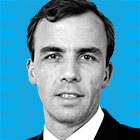

 AntonioGonzález,Tobias Stingelin&Teamcredit SuisseFirst-Place外观:1
AntonioGonzález,Tobias Stingelin&Teamcredit SuisseFirst-Place外观:1总出现:11
团队首次亮相:1993年
Credit Suisse的拉丁美洲零售分析师“非常专注于为其客户创造新的想法并为其客户创造附加价值”,“观察一位投资者。“他们不担心有争议的观点,并准备捍卫他们。”AntonioGonzález.在墨西哥城和圣保罗总部Tobias Stingelinhead up the coverage, overseeing a three-strong squad that advances to third place after six straight runner-up appearances — and posts the firm’s strongest showing since 2002. The pair also guides a crew that earns a runner-up spot on the Food & Beverages lineup. González, 31, signed on with Credit Suisse in February 2007, armed with a bachelor’s degree in economics from the Instituto Tecnológico Autónomo de México. He made his first appearance on this lineup in 2013, as co-leader with Gustavo Wigman, who decamped for Brazilian asset manager Tarpon Investimentos. Stingelin, 42, arrived at the firm that August, joining from Santander, whose group he led to runner-up positions on this roster in 2012 and 2013. He previously worked as an analyst on both the sell and buy sides, including stints at J.P. Morgan and 3G Capital, and served as an investor relations manager at Brazilian brewer Cia. de Bebidas das Américas. Stingelin graduated with a BA in business administration from the Fundação Getúlio Vargas in São Paulo. He focuses on Brazilian names, while González and one other analyst tend to non-Brazilian companies. Together they monitor 32 stocks. “We are positive on the consumer space in Mexico and cautious elsewhere in the region,” reports González. “Mexico has reached an inflection point in consumer dynamics after a couple of years of very weak growth. The fiscal reform implemented in 2014 in Mexico significantly impacted disposable income — and across the consumer subsegments, you could see companies hurting because of that.” The researchers are more cautious on Chile and Colombia, believing each has yet to experience the full impact to disposable incomes from policy changes passed more recently than those in Mexico. Regarding Brazil, “we are currently bearish on the consumer sector as the economy is clearly in the midst of a recession, and it will take some time for the outlook to improve. Unemployment rates are starting to rise fast, and inflation has been approaching 9 percent,” says Stingelin. “Moreover, consumer confidence is very low, and credit growth has been anemic. The economy has not yet reached bottom, and the outlook will continue to negatively impact demand.”
